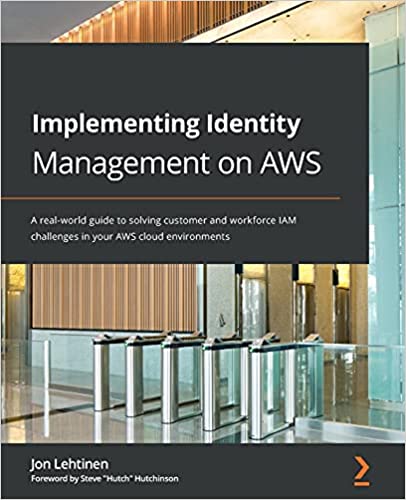Jon is the author of Implementing Identity Management on AWS, we got the chance to sit down with him and find out more about his experience of writing with Packt.
Q: What is/are your specialist tech area(s)?
Jon: Identity & Access Management
Q: How did you become an author for Packt? Tell us about your journey. What was your motivation for writing this book?
Jon: I’ve spent the last 6 years on the conference circuit. Even though they took a lot of time and effort, I enjoyed challenging myself to identify, develop, and then tell a compelling story around technology implementation and affecting business outcomes using identity & access management. Then all of those opportunities screeched to a halt in 2020 as conferences were canceled. After about six months of not having that created outlet, I was invited to submit an outline on identity on AWS by Pakt. By that time, I was eager to take on a new project to fill the void that the suspension of conferences had left. I approached that
outline by drawing on my own experiences and frustrations I had when applying broad identity concepts on the platform as a mid-career Identity Administrator. I wanted to create the book that would have more-quickly bootstrapped my effectiveness in applying identity to the platform.
Q: What kind of research did you do, and how long did you spend researching before beginning the book?
Jon: I spoke with my expansive network of identity practitioners to hear what their frustrations were when learning about AWS. I read the documentation available from Amazon, which was thorough, but written from the perspective of someone who approached the platform as a developer. As I aggregated the experiences of practitioners working in AWS, I knew I was on the right track.
Q: Did you face any challenges during the writing process? How did you overcome them?
Jon: The challenges I had were less with creating the book, rather in navigating a series of unexpected life events that happened while I was writing. Had I any inkling of what the future would hold for me in terms of professional and personal challenges over the course of the the writing process, I don’t think I would have taken it on. I joined a leading identity vendor in an exciting, but supremely challenging, role. Shortly thereafter, we experienced a health crisis in my family that required lots of time, travel, and attention. We experienced a death in the family 11 days before I turned in the draft for my final chapter. Whereas I cannot say I was unfazed by all of the tumult around me, I was able to make slow, steady progress by making incremental progress on the project each day. Slow and steady won the race.
Q: What’s your take on the technologies discussed in the book? Where do you see these technologies heading in the future?
Jon: Each identity service on AWS makes sense once you figure out their intended use case which is not always clear. AWS is making great strides to simplify applying identity, particularly administration, on their platform, and I expect that refinement to continue as complexities are abstracted away.
Q: Why should readers choose this book over others already on the market? How would you differentiate your book from its competition?
Jon: Identity on AWS may be an “old” topic, but it’s evergreen for identity practitioners who must often learn by solving for specific business use cases, usually under very tight time constraints. I approached what I was writing from the perspective that it should be “the guide I wish was available to me when I had to quickly solution for IAM on AWS for a project with a deadline.” I don’t pretend to offer a comprehensive guide for learning AWS, nor even the full breadth and depth of just the identity services available through AWS. Rather, I wanted to deconstruct how identity is delivered on AWS, and provide a practitioner’s-eye view for learning about and solutioning on the platform. Once someone gets their sea legs by hearing about this topic using language and concepts familiar to them, they will be more than capable and confident that they can contiue to expand their AWS expertise to as high a degree as they want.
Q. What are the key takeaways you want readers to come away from the book with?
Jon:
I have made my peace with not knowing everything, and accepting feedback and correction when I am mistaken. Many early and mid-career professionals haven’t reconciled their fears over being esteemed as an expert while still not knowing everything.” Identity on AWS may be an “old” topic, but it’s evergreen for identity practitioners who often learn by solving for
use cases, typically under a time crunch. I want readers to understand that whereas this book represents a great way to bootstrap themselves with the knowledge they need to react to those challenges, the more important thing is empowering them to delve deeper into those topics and technologies beyond what I present in the book.
Q. What advice would you give to readers learning tech? Do you have any top tips?
Jon: A small amount of professional development yields incredible dividends for your career. Approach your entire career with the humility to always expect to be able to learn more on a topic, and overtime you will become “the expert” in the eyes of others who are just starting their own professional journeys
Q. Do you have a blog that readers can follow?
Jon: Every now and then I post to my account on Medium, but if have something significant to say or publish it will be found on my LinkedIn feed. Following me on LinkedIn is the best way to see when I have published anything.
Q. Can you share any blogs, websites and forums to help readers gain a holistic view of the tech they are learning?
Jon: The AWS documentation, IDPro Slack
Q. How would you describe your author journey with Packt? Would you recommend Packt to aspiring authors?
Jon: Pakt made the process of book writing approachable. I would recommend working with Packt if you think you have something to share
Q. Do you belong to any tech community groups?
Jon: Member of the Board of Directors, Treasurer
Kantara Initiative
OpenID Foundation
Women in Identity
ISC2
Richmond and Washington DC IAM groups on Meetup
Q. What are your favorite tech journals? How do you keep yourself up to date on tech?
Jon: I use the IDPro slack channel which is available for members to see what is new and novel in technology. I also follow other identity practitioners on Twitter
Q. How did you organize, plan, and prioritize your work and write the book?
Jon:
I approached this like any other conference talk or work that will be delivered to a public audience. I think first about “the story I want to tell” and how to tell it clearly, along with the key items I wish to communicate with my audience. That outline guides my research and content, and I find that as I research the topic, a natural flow for presenting the information that resonates with me starts to form. I then flesh out the topics within that flow
Q. What is that one writing tip that you found most crucial and would like to share with aspiring authors?
Jon: Write each day. Even if you sat down and produced a few sentences, you are still further
ahead than had you not done so.
You can find Jon ‘s book on Amazon by following this link









